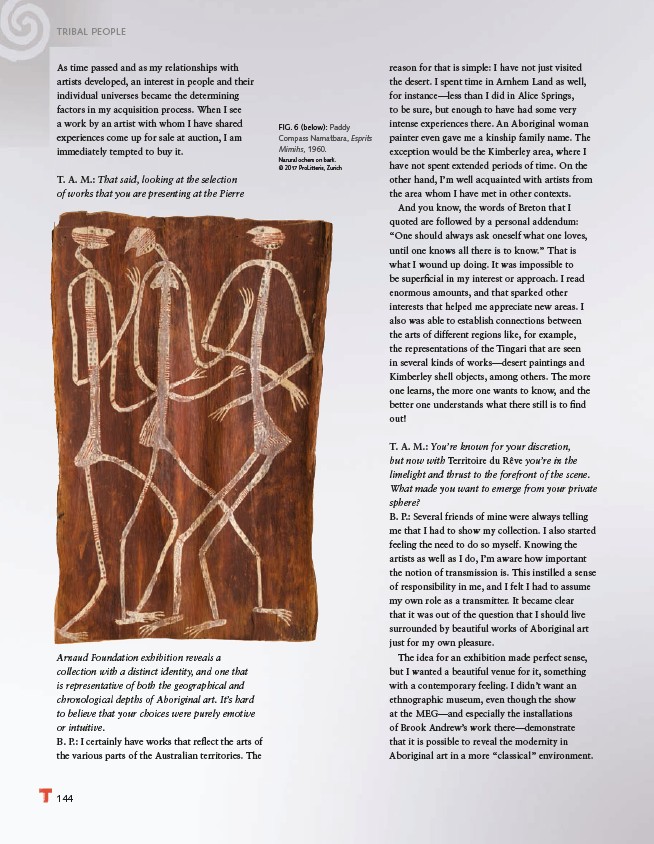
TRIBAL PEOPLE
Arnaud Foundation exhibition reveals a
collection with a distinct identity, and one that
is representative of both the geographical and
chronological depths of Aboriginal art. It’s hard
to believe that your choices were purely emotive
or intuitive.
B. P.: I certainly have works that refl ect the arts of
the various parts of the Australian territories. The
144
FIG. 6 (below): Paddy
Compass Namatbara, Esprits
Mimihs, 1960.
Narural ochers on bark.
© 2017 ProLitteris, Zurich
reason for that is simple: I have not just visited
the desert. I spent time in Arnhem Land as well,
for instance—less than I did in Alice Springs,
to be sure, but enough to have had some very
intense experiences there. An Aboriginal woman
painter even gave me a kinship family name. The
exception would be the Kimberley area, where I
have not spent extended periods of time. On the
other hand, I’m well acquainted with artists from
the area whom I have met in other contexts.
And you know, the words of Breton that I
quoted are followed by a personal addendum:
“One should always ask oneself what one loves,
until one knows all there is to know.” That is
what I wound up doing. It was impossible to
be superfi cial in my interest or approach. I read
enormous amounts, and that sparked other
interests that helped me appreciate new areas. I
also was able to establish connections between
the arts of different regions like, for example,
the representations of the Tingari that are seen
in several kinds of works—desert paintings and
Kimberley shell objects, among others. The more
one learns, the more one wants to know, and the
better one understands what there still is to fi nd
out!
T. A. M.: You’re known for your discretion,
but now with Territoire du Rêve you’re in the
limelight and thrust to the forefront of the scene.
What made you want to emerge from your private
sphere?
B. P.: Several friends of mine were always telling
me that I had to show my collection. I also started
feeling the need to do so myself. Knowing the
artists as well as I do, I’m aware how important
the notion of transmission is. This instilled a sense
of responsibility in me, and I felt I had to assume
my own role as a transmitter. It became clear
that it was out of the question that I should live
surrounded by beautiful works of Aboriginal art
just for my own pleasure.
The idea for an exhibition made perfect sense,
but I wanted a beautiful venue for it, something
with a contemporary feeling. I didn’t want an
ethnographic museum, even though the show
at the MEG—and especially the installations
of Brook Andrew’s work there—demonstrate
that it is possible to reveal the modernity in
Aboriginal art in a more “classical” environment.
As time passed and as my relationships with
artists developed, an interest in people and their
individual universes became the determining
factors in my acquisition process. When I see
a work by an artist with whom I have shared
experiences come up for sale at auction, I am
immediately tempted to buy it.
T. A. M.: That said, looking at the selection
of works that you are presenting at the Pierre